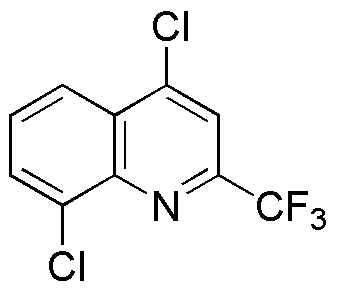4,8-Dichloro-2-(trifluoromethyl)quinoline is widely utilized in research focused on:
- Pharmaceutical Development: This compound serves as a key intermediate in the synthesis of various pharmaceuticals, particularly in developing anti-infective agents and anti-cancer drugs, enhancing therapeutic options.
- Agricultural Chemicals: It is used in formulating agrochemicals, including herbicides and fungicides, providing effective solutions for pest control while minimizing environmental impact.
- Material Science: The compound is explored for its potential in creating advanced materials, such as polymers and coatings, which exhibit enhanced durability and resistance to degradation.
- Analytical Chemistry: It acts as a reference standard in analytical labs for the detection and quantification of related compounds, ensuring accuracy in research and quality control processes.
- Biochemical Research: Researchers utilize this compound to study its interaction with biological systems, aiding in the understanding of disease mechanisms and the development of targeted therapies.
General Information
Properties
Safety and Regulations
Applications
4,8-Dichloro-2-(trifluoromethyl)quinoline is widely utilized in research focused on:
- Pharmaceutical Development: This compound serves as a key intermediate in the synthesis of various pharmaceuticals, particularly in developing anti-infective agents and anti-cancer drugs, enhancing therapeutic options.
- Agricultural Chemicals: It is used in formulating agrochemicals, including herbicides and fungicides, providing effective solutions for pest control while minimizing environmental impact.
- Material Science: The compound is explored for its potential in creating advanced materials, such as polymers and coatings, which exhibit enhanced durability and resistance to degradation.
- Analytical Chemistry: It acts as a reference standard in analytical labs for the detection and quantification of related compounds, ensuring accuracy in research and quality control processes.
- Biochemical Research: Researchers utilize this compound to study its interaction with biological systems, aiding in the understanding of disease mechanisms and the development of targeted therapies.
Documents
Safety Data Sheets (SDS)
The SDS provides comprehensive safety information on handling, storage, and disposal of the product.
Product Specification (PS)
The PS provides a comprehensive breakdown of the product’s properties, including chemical composition, physical state, purity, and storage requirements. It also details acceptable quality ranges and the product's intended applications.
Certificates of Analysis (COA)
Search for Certificates of Analysis (COA) by entering the products Lot Number. Lot and Batch Numbers can be found on a product’s label following the words ‘Lot’ or ‘Batch’.
*Catalog Number
*Lot Number
Certificates Of Origin (COO)
This COO confirms the country where the product was manufactured, and also details the materials and components used in it and whether it is derived from natural, synthetic, or other specific sources. This certificate may be required for customs, trade, and regulatory compliance.
*Catalog Number
*Lot Number
Safety Data Sheets (SDS)
The SDS provides comprehensive safety information on handling, storage, and disposal of the product.
DownloadProduct Specification (PS)
The PS provides a comprehensive breakdown of the product’s properties, including chemical composition, physical state, purity, and storage requirements. It also details acceptable quality ranges and the product's intended applications.
DownloadCertificates of Analysis (COA)
Search for Certificates of Analysis (COA) by entering the products Lot Number. Lot and Batch Numbers can be found on a product’s label following the words ‘Lot’ or ‘Batch’.
*Catalog Number
*Lot Number
Certificates Of Origin (COO)
This COO confirms the country where the product was manufactured, and also details the materials and components used in it and whether it is derived from natural, synthetic, or other specific sources. This certificate may be required for customs, trade, and regulatory compliance.


